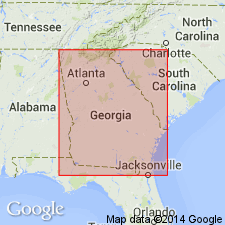
- Usage in publication:
-
- Marion Member
- Modifications:
-
- Named
- Dominant lithology:
-
- Sand
- Clay
- AAPG geologic province:
-
- South Georgia sedimentary province
Summary:
Marion Member of the Huber Formation is named in Twiggs Co., central GA. The Marion is a kaolinitic sand deposit at the base of the Huber. It is the thickest and most widespread component of the Huber in central GA and is the only component of the Huber now exposed at the type locality of the formation in Huber Pit 30. The Huber is assigned to the Oconee Group (new), which encompasses all pre-late Eocene kaolin and kaolinitic sand deposits of fluvial origin in the Fort Valley plateau and Fall Line Hills districts. The Marion is characteristically a predominantly horizontal, undulatory, to cross-bedded sand with scattered occurrences of quartz pebbles and gravel, lenses of kaolin, and lenses of carbonaceous of lignitic sediments. Thickness at the type section is 23 m; thickness in Huber Pit 30 (the type section of the Huber Formation) is less than 5 m. Underlies the Jeffersonville member (new, informal) where present or disconformably underlies the Mossy Creek Sand (new) of the Barnwell Group; disconformably overlies the Gaillard Formation (new) of the Oconee Group. Grades laterally into the Marshallville Formation (new) of the Fort Valley Group. Age is early Paleocene (Midwayan).
Source: GNU records (USGS DDS-6; Reston GNULEX).
For more information, please contact Nancy Stamm, Geologic Names Committee Secretary.
Asterisk (*) indicates published by U.S. Geological Survey authors.
"No current usage" (†) implies that a name has been abandoned or has fallen into disuse. Former usage and, if known, replacement name given in parentheses ( ).
Slash (/) indicates name conflicts with nomenclatural guidelines (CSN, 1933; ACSN, 1961, 1970; NACSN, 1983, 2005, 2021). May be explained within brackets ([ ]).

